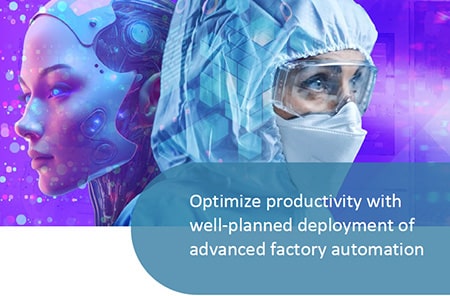Pre-Implementation planning
Before diving into the implementation process, it is vital to establish clear project objectives and define the scope of the new software. During this “planning before implementing” phase, it’s crucial to work closely with the customer to obtain an honest assessment of the organization’s readiness for change. Equally important is assembling a Change Management Team. These are fundamental first steps in ensuring a successful transition to a newly implemented system.
TIP: It’s important for all those affected to be represented and heard. For example, when both “global” and “site” stakeholders are involved, the system is more representative of the needs of the business and there is a smoother adoption process. This highlights how implementation of new software solutions has the potential to affect the entire organization, rather than just one set of stakeholders. When all stakeholders are involved, everyone has a vested interest in the successful outcome – there is something for everyone! This is particularly important in such a rapidly evolving industry as the pharma/biopharma development and manufacturing space.
Stakeholder analysis and engagement
Understanding the needs, expectations, and concerns of key stakeholders is paramount. Identifying stakeholders and their roles, analyzing their perspectives, and creating a comprehensive communication plan to engage them will set the foundation for a collaborative and well-supported implementation process.
TIP: Much like pre-implementation planning, it is important to get the right people in the room early on to understand their concerns, ideas and expectations. It is an obvious but important point, otherwise key stakeholders’ voices will not be heard, which could lead to requests for changes to the program or delayed commissioning. When time and resources are dedicated in the planning phase, it saves overall implementation time and allows the value from the solution to be welcomed and realized sooner.
Change impact assessment
Evaluating the impact of new software on existing processes, workflows, and roles is essential. This step allows organizations to anticipate potential risks and challenges associated with the change. At this point, they should not only assess risk, but also the effect on the working practices of teams. By developing strategies to mitigate these risks, address challenges, and recognize opportunities, organizations can minimize disruptions and prepare for a smooth transition.
TIP: Whenever a significant software implementation takes place, it undoubtably will impact not only the processes and workflows involved but also the people. When the Change Impact Assessment is done up front, taking both people and processes into account, we notice a significantly smoother implementation.
Change planning and implementation
Creating a detailed plan is crucial for any successful implementation. Allocating resources effectively, setting realistic timelines, and providing comprehensive training and support to end-users will help them adapt to the new software and processes more smoothly. This step ensures that everyone involved is equipped with the necessary knowledge and skills to embrace the change.
TIP: We often see this step make the difference between highly successful implementations and those that take longer to be accepted and return the expected value. It’s ultimately the customer’s responsibility to provide resources for effective training and to support change. However, this is an important area where establishing requirements and ownership in the project definition stages delivers clarity and confidence. Having a flawless implementation but not dedicating sufficient time and resources for training jeopardizes long-term success and value creation. Don’t wait until the end to do the training! We find it helpful to train the team throughout the implementation, rather than waiting.
Communication and change adoption
Effective communication is at the heart of change management. Customers with successful implementations communicate the benefits and purpose of the new software to stakeholders and gain insight before the project begins. Throughout the implementation, they continue to inform and review progress. Post deployment, they share the benefits. This continuous flow of communication enables teams to address any concerns as they arise, provide ongoing support and share successes along the way. Two-way communication fosters a sense of involvement, builds trust, and encourages stakeholders to embrace the change, actively participate in the implementation process, and share in the success.
TIP: Long-term benefit and value creation depend upon this step. It’s important to communicate the benefits and purpose of the new software. Experience working within the pharma industry has shown that it is equally important to communicate the value the implementation will bring in terms of immediate gains and long-term improvements. Ideally, the value needs to be clearly stated and agreed upon with the stakeholders. We find it crucial to enumerate the value a software implementation will bring. Even with limited financial data to do a thorough analysis, there is always a way to demonstrate value.
Monitoring and evaluation for ongoing success
Once a new software is in place, monitoring its adoption and effectiveness is essential. Collecting feedback from stakeholders and evaluating the impact of the change allows organizations to promptly address any issues that arise. Adjusting and making improvements based on evaluation of results ensures that the software implementation aligns with the expectations, as defined by goals and objectives.
TIP: It may be tempting to claim the software implementation is over when all the customer requirements have been met and that the solution was installed as agreed upon. From experience, though, an implementation will be much more successful if adoption is monitored and the value captured is clearly demonstrated over time. Keeping an eye on adoption ensures that value creation will continue.
Significance of stakeholder analysis and engagement
Robust stakeholder analysis and engagement are vital throughout any new software implementation process. By thoroughly understanding stakeholders’ needs, expectations, and concerns, change management strategies can be tailored accordingly. This analysis, combined with shared communications, enables organizations to mitigate resistance to change, address concerns proactively, and build support and buy-in from stakeholders. Engaging stakeholders from the beginning fosters collaboration, effective communication, and a sense of ownership, which are all crucial elements for successful software implementation and ongoing utilization.
To learn more about our Proof of Value approach for successful new software implementations in pharma process development and manufacturing, contact our SmartFactory Rx project development team Contact Us Here


